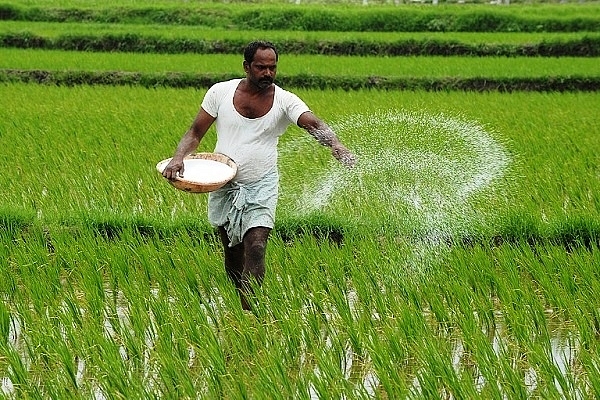Economy
Green Shoots: Economy Stands To Gain As Rabi Season Sowing Set For New Record On Higher Support Price
- Encouraged by Prime Minister Narendra Modi’s vow of higher support price, India is witnessing record sowing this rabi season. This could be the green shoots of recovery.

A farmer sprinkles pesticides in his field.
Those looking for the green shoots in the economy should find the latest sowing data of the rabi (winter) crops encouraging.
A heartening feature for the Narendra Modi government, which is under pressure from the critics for slower growth in recent months, is that sowing of wheat, rice, pulses and oilseeds have already exceeded the normal area (average area under a crop in the last 10 years) under rabi.
This is the trend as on 16 January and if this continues, we could witness record rabi sowing of wheat, rice, gram (chana), rapeseed/mustard, lentils, kulthi, barley and other pulses. Sowing in some crops could continue until this month-end.
Overall rabi acreage is higher at 64.14 million hectares (mh) against the normal 63.4 mh and last year’s 60.03 mh. There are a couple of reasons why sowing of rabi crops this year is higher than the normal coverage.
One of the reasons for higher sowing is the government’s decision to raise the minimum support price (MSP) in tune with its policy to ensure farmers get 1.5 times the return of the crop production cost.
This has ensured impressive MSP for crops such as lentils (rates hiked by Rs 3,250/tonne), rapeseed/mustard (Rs 2,250/tonne hike), wheat, barley (both Rs 850/tonne hike) and gram (Rs 2,550/tonne hike).
A higher MSP necessarily need not result in a higher coverage of the respective crop. Farmers have been encouraged to go for higher planting also because last year, various parts of the country witnessed unusual rainfall until 10 November.
Though the rains wrecked the kharif (summer) crops growth and harvest, particularly onion, soybean, cotton and rice, they helped in improving the soil moisture. Better soil moisture aided increasing planting of the rabi crops.
Another reason that is encouraging and could even stand in good stead for early kharif crops sowing such as groundnut in Gujarat is the higher water storage in the major reservoirs of the country.
According to the Central Water Commission, the water level in the 95 major reservoirs in the country that help irrigation is 96.554 billion cubic metres (BCM) against the full capacity of 125.19 BCM. This is 77 per cent of the capacity.
Last year, the water level was 58.23 BCM (47 per cent of capacity), while the average storage level (of last 10 years) is 64.353 BCM (51 per cent of capacity).
The storage level in Himachal Pradesh and Tripura is lower than last year, while in Punjab it is the same as last year. In the rest of the states, the water level is higher than last year.
The higher than average sowing and conducive conditions for rabi crops mean there could be a renewed activity in rural India from mid-March. This promises a good start to the next financial year starting April.
If the higher acreage can lead to higher production, then the much required spending in rural India will take place on a larger scale. That will lead to an increased demand for white goods, fast moving consumer goods, automobiles and even luxury goods.
Finance Minister Nirmala Sitharaman and her team in the Finance Ministry could perhaps be relying on a record if not higher rabi crops production when the Union Budget will be tabled in Parliament on 1 February.
There is one fear, though. Farmers could face the problem related to production glut which can lead to distress sale by them. It would be prudent on the part of the Centre to watch out and be prepared against such a development.
Support Swarajya's 50 Ground Reports Project & Sponsor A Story
Every general election Swarajya does a 50 ground reports project.
Aimed only at serious readers and those who appreciate the nuances of political undercurrents, the project provides a sense of India's electoral landscape. As you know, these reports are produced after considerable investment of travel, time and effort on the ground.
This time too we've kicked off the project in style and have covered over 30 constituencies already. If you're someone who appreciates such work and have enjoyed our coverage please consider sponsoring a ground report for just Rs 2999 to Rs 19,999 - it goes a long way in helping us produce more quality reportage.
You can also back this project by becoming a subscriber for as little as Rs 999 - so do click on this links and choose a plan that suits you and back us.
Click below to contribute.
Latest